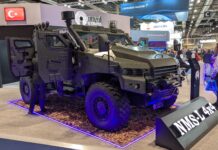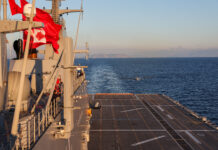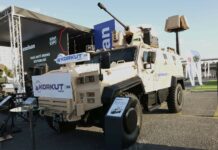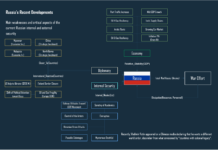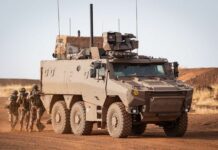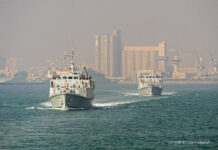
Travelling Light – Nurol Makina Details its 4×4 Fleet Concept
Mark Cazalet
Turkish manufacturer Nurol Makina has been expanding its vehicle families with new variants, with the aim of promoting a light vehicle fleet concept centred around 4×4s. Emre Akin, Nurol’s head of strategic planning, along with another company representative, Brig Gen (retd) Recep Ozdemir, provided the ESD with additional details.

Credit: Nurol Makina
Emre Akin told ESD that Nurol Making is promoting its updated range of 4×4 ‘Heavy Tactical Wheeled Armoured Vehicles’ (HTWAV) for use in high-intensity conflict, rather than just low-intensity conflicts, as has been typically the case for vehicles in this class. Brig Gen Ozdemir stated that “We started with Yalçın – it was particularly for asymmetric warfare, low-intensity warfare in the beginning,” continuing, “we visualised that 4×4 vehicles were developed enough, and their ‘golden’ capabilities, which are manoeuvrability, mobility, agility, protection, survivability, and payload capacity are quite mature. And just to think of these vehicles in low-scale warfare would be unfair.”
Ozdemir added that “there are some small countries who cannot allocate enough resources for sophisticated and very expensive weapon systems, like tanks, tracked vehicles, and even 8×8 vehicles.” In response to this demand, Nurol Makina has developed a range of variants based on their 18-tonne Ejder Yalçın and 13-tonne NMS (known as ‘Yörük’ in Turkish) 4×4 platforms, which would be considered heavy wheeled platforms within their class. These two families of vehicles are being offered for the combat, combat support, and combat service support segments within a 4×4 fleet concept. For instance, in the ‘combat support’ segment, which Nurol Makina envisions as being used just behind the front lines, variant options include anti-tank, very short-range air defence (VSHORAD), reconnaissance, command, and mortar variants. This is intended to provide users with organic capabilities at lower costs compared to 8×8, 6×6, or medium-weight tracked platforms employed in the same role.
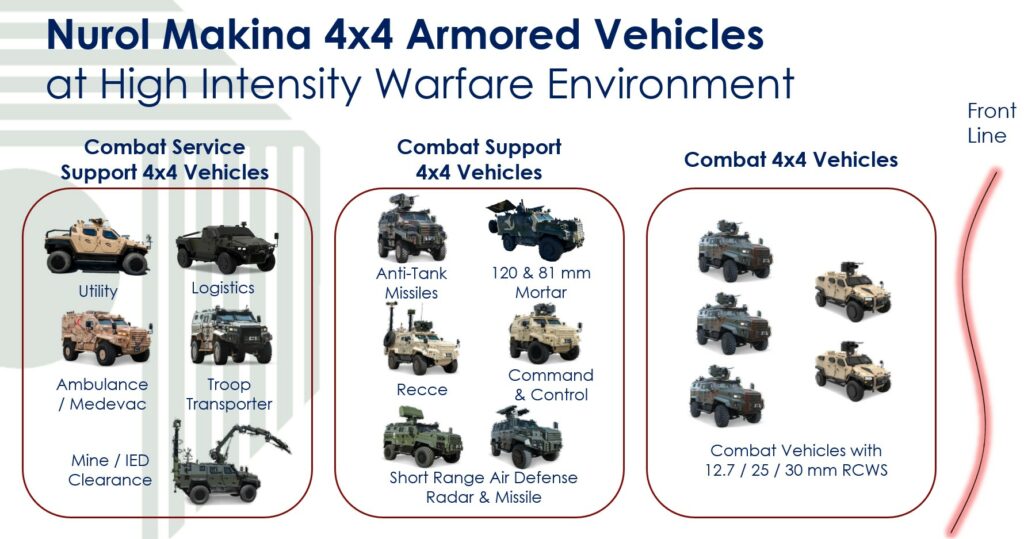
Credit: Nurol Makina
High costs for many vehicle types is indeed a problem, and is one of the reasons why armed forces today broadly operate much smaller vehicle fleets than they did during the Cold War. While modern vehicles are generally both more capable and survivable than their forbears, being restricted to operating a smaller fleet of these brings its own restrictions to the battlefield. For instance, a heavy force with fewer vehicles may not be able to cover as broad a front as a force built on greater numbers of lighter vehicles. While each individual element in the lighter formation may be less protected than a heavier alternative, their greater numbers, higher top speeds, and easier deployability can nonetheless create tactical opportunities which may be hard to achieve otherwise.
Availability is another concern, as concentrating sophisticated capabilities onto heavier platforms will also make them high-value targets, and very in-demand by low-level commanders during wartime. This puts higher-echelon commanders in the position of having to carefully weigh where these vehicles can be committed to. In this vein, Ozdemir stated that at the “battalion plus brigade level, lots of capabilities should be organic, must be under the hand of the commander,” adding: “it is not possible to ask the brigade commander: ‘Sir, can you please send me four CV90s or four tanks (which are probably assigned to more critical tasks) to conduct this task which is not very challenging considering the mission, enemy and terrain,’ but it is possible to ask for tactical wheeled protected vehicles to [carry out] a relatively less challenging task, so these are really very good tools for the low-level commanders, and there are lots of gaps to be filled by using those agile platforms.”
In this vein, the employment of 4x4s as weapons carriers allows a force to push organic capabilities such as mobile mortars or light artillery, Counter-UAV (C-UAV) or Short-Range Air Defence (SHORAD), and direct fire support down to low echelons for a relatively low cost. Various forces have already started acquisitions of 4×4-based weapon carriers, with mobile mortars becoming a relatively popular offer in this segment, due to many 4×4 platforms being perfectly adequate for this role, as a representative noted: “You don’t need Boxer for this capability.” Beyond mortars, following on from the Second Nagorno-Karabakh war and the War in Ukraine, demand for organic mobile C-UAV and SHORAD capabilities in particular is increasing, especially for countries without large air forces. Fulfilling these requirements using heavier platforms is likely to be prohibitively expensive for some armed forces.
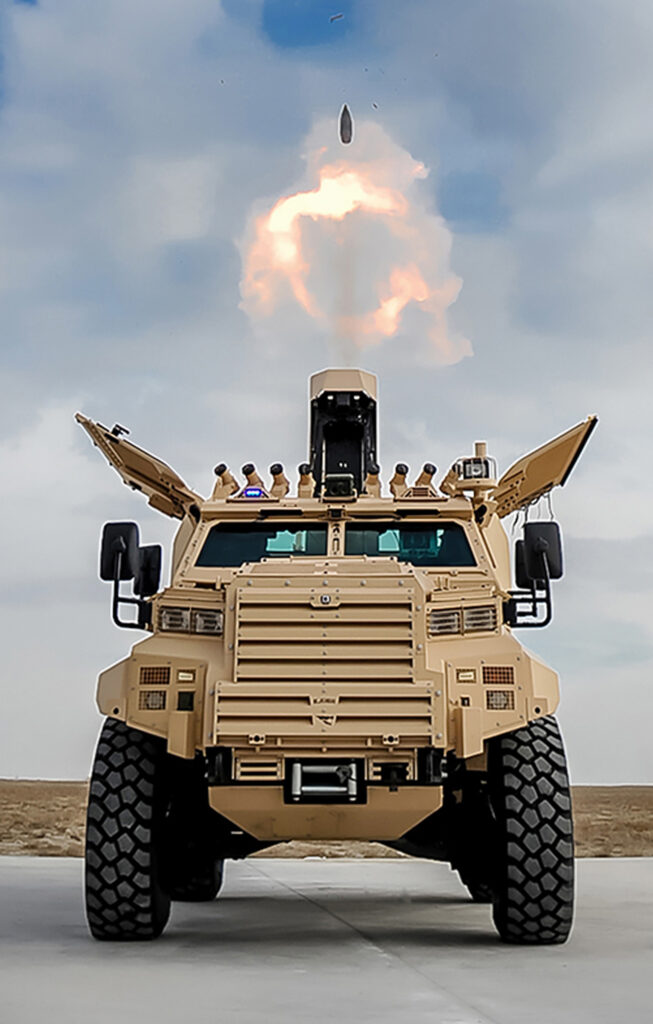
Credit: Nurol Makina
‘Better’ is the Enemy of ‘Good Enough’
There are other reasons why it can be advantageous for smaller countries in particular, who tend to have relatively small armed forces to begin with, to operate a larger fleet of lighter, less protected vehicles, than a larger number of heavy vehicles.
Going the lightweight route provides a number of benefits for such users – protected 4×4s are cheaper to procure and operate, repair, and train on than 8×8s, 6×6s or medium-weight tracked vehicles. As Ozdemir stated, “Another beauty of these [4×4] vehicles – for tanks, for tracked vehicles, you have to train your guys intensively, you have to spend lots of time for this. If you lose those guys, you have to train new guys, and it takes time. But these [4×4] vehicles are very simple, they are like commercial vehicles.”
Secondly, many 4×4 protected vehicles have sufficient payload headroom to be equipped with most of the same armament and mission system options as their heavier counterparts, with the exception of large guns and automatic cannons. As an example, the Northrop Grumman M230LF, chambered in 30 mm × 113 would represent the typical upper limit of their armament. Due to the lower roof-mounted weight limits of 4×4s compared to 6×6s or 8×8s, they also will generally not be able to carry as much ammunition, meaning they would need to be resupplied more frequently, but their relative numbers and availability can compensate for this somewhat.
Smaller vehicles can suffer more than their larger cousins in some mobility scenarios, such as fording, obstacle climbing, and trench crossing, where the 4×4 is inherently at a disadvantage compared to tracked, 6×6, and 8×8 vehicles. Having said this, their lower weight and typically lower profile allows 4×4s to more easily navigate civilian infrastructure such as bridges and pass underneath obstacles which would hinder a larger vehicle, and makes them easier to recover when they get stuck.
However, where lighter vehicles really shine is in the strategic mobility department. Modern medium-weight wheeled and tracked vehicles are difficult to transport them in large numbers using aircraft. As an example, it takes three A400M aircraft to transport two Boxer 8×8s, and the process requires decoupling the vehicles’ mission modules from their drive modules, loading both mission modules onto one aircraft, while the remaining two aircraft each take a drive module. Although the A400M can carry a payload of 37 tonnes, which Boxer comes close to at a typical combat weight of 36.5 tonnes, the loading ramp’s weight tolerance is only 32 tonnes. Thus, the load needs to be decreased before the vehicle can be driven on and off the aircraft. By contrast, something like the Ejder Yalçin, although no featherweight at around 14-18 tonnes (depending on version and configuration), is sufficiently light to drive on or drive off A400M, and at this weight, two could be carried per aircraft. If the vehicle is equipped with a relatively tall roof-mounted remote weapon station, this may be a little on the tall side for A400M and would require removal prior to driving on, but this limitation would apply to most tall armoured fighting vehicles.
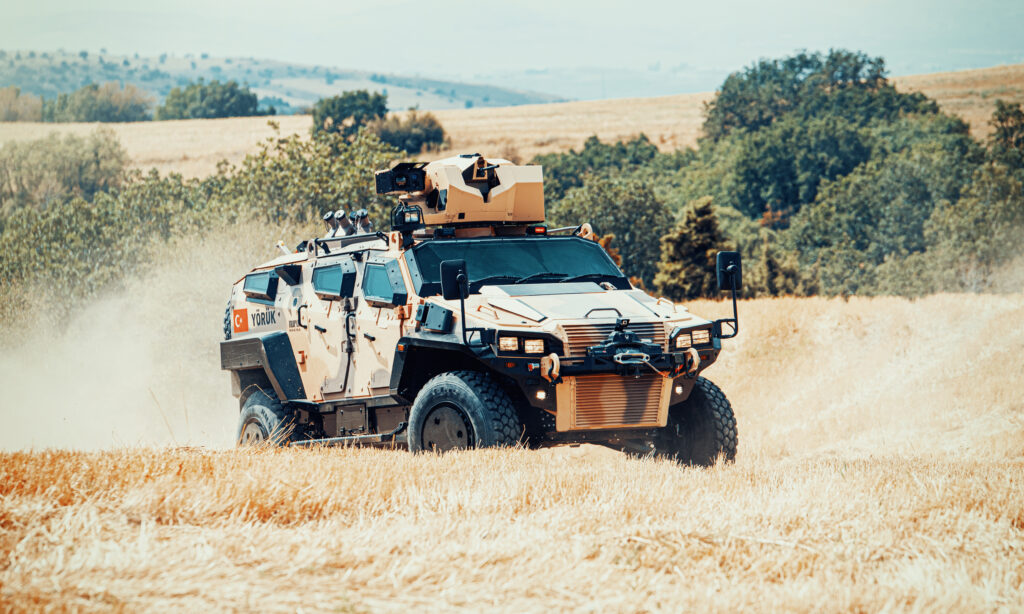
Credit: Nurol Makina
What is Sufficient Protection on the Modern Battlefield?
On the protection side, 4×4s may lack the same level of passive armour protection as heavier vehicles, however this may be less relevant than it once was. While heavy machine guns and automatic cannons remain very common threats, the proliferation of relatively low-cost but effective Anti-Tank Guided Missiles (ATGMs) and loitering munitions has had two main changes on the battlefield. Firstly, combatants everywhere generally feel more comfortable using these weapons for engaging any kind of target. This was perhaps best exemplified in Syria, where various factions have used ATGMs such as TOW, Fagot, Konkurs, Kornet against everything from heavy to very light vehicles, buildings, and even personnel in the open. Secondly, this has meant that realistically, unless they are equipped with an active protection system (APS), any vehicle with armour protection below the level of a modern tank (and even some tanks) can be reliably defeated with ATGMs which are fairly common on today’s battlefields.
RPGs have also grown in capability, with modern tandem-HEAT warhead varieties having comparable terminal effects to ATGMs. Although even modern RPGs typically have slightly lower overall penetration compared to modern ATGMs, this factor is largely irrelevant for most vehicles on the battlefield, whose armour can be comfortably overmatched at a fraction of their total penetrative capability. Older RPG variants such as the PG-7V and PG-9V families of munitions meanwhile, are usually countered by statistical protection such as bar armour, which can be fitted to heavy or light vehicles alike.
On the topic of survivability, Nurol Makina provided ESD with a first-hand account of an ambush from a soldier working as the driver of an Ejder Yalçın with the Gendarmerie Commando unit based in south-eastern Turkey, close to the Iraqi border. The soldier did not wish to be identified, but described the ambush to ESD, which took place near the town his unit was based:
“In the summer of 2019, when I was working with the Gendarmerie Commando unit in [south-eastern Turkey], we set off for road controls and [searched for] IEDs in culverts, with [our] vehicle in the early morning hours. Together with my commando friends and commanders, we continued to work very carefully all day and the duration of our duty was extended. We had done all the culvert and IED searches. We waited until the evening hours [at a small temporary base]. After taking a break, we received information [from] the military convoy coming from [a town located 52 km from us] and started patrolling. I was [in the lead] with my vehicle that day. We identified a heat source through our thermal camera and stopped while we were on patrol. As soon as we stopped, two [RPGs] hit my vehicle, 10 seconds apart. We tried to exit the death zone [calmly] with my vehicle commander and personnel. We got out of the death zone using the special abilities of our vehicle.”

Credit: Nurol Makina
According to Nurol Makina, both RPGs had struck the engine area of the vehicle, and the vehicle was heavily damaged in the attack, including damage to the electronics and one of the tyres, but fortunately, the RPGs’ penetrating shaped charge jets did not strike at the correct angle to cause damage to the engine. Thus the driver was able to continue driving for four kilometres, bringing the crew to safety before leaving the vehicle. Akin added that due to the danger posed by hits on the engine, which would immobilise the vehicle and leave the crew unable to escape, the Ejder Yalçın has the same level of armouring around the engine bay as around the passenger compartment. This provides the engine with protection against machine gun, blast, and fragmentation threats, helping the vehicle to preserve its mobility when hit.
The vehicle is also highly mine and IED-resistant. Recalling another incident featuring the Yalçın, Akin stated that in 2015, Southeastern Turkey, a fertiliser-based IED weighing than 600 kg (somewhere in the realm of >10 kg of TNT equivalent) exploded under the vehicle body. While this caused significant damage to the vehicle, the occupants survived. Akin stated that during tests in 2022, the vehicle’s underbody was demonstrated to provide protection conforming to STANAG 4569 Level 4A/4B, translating to 10 kg of TNT equivalent under the body or under any wheel location. This level of protection is being offered as an option depending on user requirements.
Closing Thoughts
In sum, while protected 4×4 vehicles in the medium-weight category are never going to be capable of doing everything their heavier brethren can do, yet they nonetheless offer a number of compelling reasons for increasing their participation in high-intensity warfare, rather than being left to counter-insurgency operations.
Recalling Ukraine’s high-speed counteroffensive around Kharkiv launched on 6 September 2022, after Russia had redeployed many of its more capable forces in the East of Ukraine to protect Kherson in the South. Ukraine’s rapid response caught Russian forces off-guard. Although Ukraine’s forces used all manner of equipment during the campaign, they notably made use of large numbers of light (some of which unarmoured), or medium-weight protected 4×4s to rapidly move personnel forward. Speed was absolutely key to this operation, as it gave the unprepared Russian forces little time to organise a defence or even sabotage their own equipment before retreating. The result was Ukrainian forces retaking over 500 settlements, and around 12,000 km2 of territory, along with large stocks of captured Russian equipment in working order.
Nurol Makina’s proposed force concept may not be the highest priority for users who already operate large, modern medium-weight and heavy vehicle fleets, supported by various other systems on the ground and in the air. However, it is admittedly a rather compelling model for users with more limited budgets, as well as for countries gearing up for a mix of counter-insurgency and high-intensity conflict tasks, or users who wish to increase their share of organic capabilities at very low levels.
Mark Cazalet





